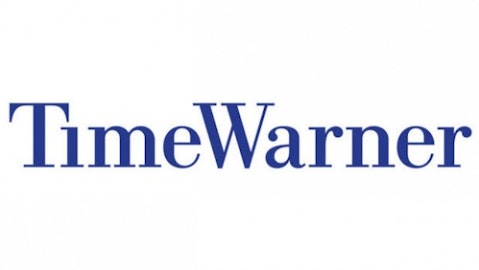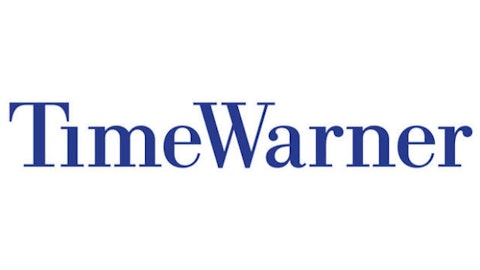Media giant Time Warner Inc. (NYSE:TWX) posted quarterly earnings of $1.21 per share, or $1.17 billion, an increase from the 76 cents per share, or $773 million, it reported in the prior year quarter. After adjusting for one-time benefits and charges, the company earned $1.17 per share, surpassing the FactSet analyst average forecast by 7 cents. However, revenue slid from $8.19 billion to $8.16 billion, missing the $8.22 billion analysts had forecast.
Its subsidiary HBO also reported strong overseas subscribers, despite unfavorable currency impacts. The popularity of its shows has led to a 7% increase in revenue from distributor and subscription fees, while ad revenue grew 3%.

Time Warner’s Risk / Reward Ratio to Improve
The company’s risk / reward profile is favorable for long-term investors, and going forward it’s expected to improve even further based on the following factors:
1). A solid and improving position for subscription fee growth in the next carriage cycle at Turner and over the longer term at HBO
2). Long-term visibility of the company’s networks programming expense — highlighted most recently by HBO’s renewal of film output deals with Fox and Universal
3). Management’s focus on capital return than big-ticket M&A, as befits a company with leading scale in all its business lines
Positive Catalysts for the Company
1). Popular shows such as the new “Dallas” boosted ratings at its Turner cable channels (TBS, TNT, and CNN)
2). “Girls” and “Game of Thrones” attracted more subscribers at its subsidiary HBO
3). Royalties from online streaming video services will help older shows generate additional revenue and these gains are expected to offset weakness in its movie studio and magazine businesses
Movie Studio and Magazine Segments Fared Poorly
Time Warner’s movie studio, Warner Bros., had weaker film releases last quarter, which couldn’t match the earning power of the “Harry Potter” series, which concluded in 2011. Although “Argo” and “The Hobbit” generated strong box office returns, they couldn’t measure up to the previous success of the “Harry Potter” franchise.
But there’s no reason to be overly pessimistic regarding the long-term prospects of the movie studio business, due to its fluctuating nature. With a strong cash position the studio business will certainly stage a turnaround in the coming quarters. Competitors like The Walt Disney Company (NYSE:DIS) and Viacom, Inc. (NASDAQ:VIAB) also witnessed similar trends, but this hasn’t created any serious pressure on these media stocks over the last twelve months. In fact, all of them are up significantly since January, last year.
People and Time were among the company’s titles with the biggest drops at the newsstand, based on an analysis of data released recently by the Alliance for Audited Media. Subscription sales rose 3%, helping boost total circulation 1% to 32.9 million. But this is a general trend thanks to the growing demand for digital magazines, better known as ezines. A few bright spots include a 5.1% rise in total circulation at Essence and an 8.5% jump for People StyleWatch magazine. Nearest competitor News Corp (NASDAQ:NWSA) is planning to spin-off its publishing business and the stock is up 45% over the last twelve months on the news.
Outlook of the Media Industry
An improving U.S. economy continues to make investors optimistic about the future growth prospects of the media companies. Apart from Time Warner, three other companies should see positive growth from a rebounding entertainment industry — driven by healthy TV ad and subscription growth — Walt Disney, Viacom and News Corp.
Disney is offering significant value to investors at 16x trailing earnings, and it trades at an attractive 13x forward earnings. With the company’s recent purchase of the “Star Wars” franchise, Disney has renewed opportunities for cross selling and sports the ability to establish a lasting relationship with the next generation of movie-lovers.
Viacom’s advertising revenue (both domestic and international) dropped significantly, primarily due to serious concerns regarding the weak viewership ratings of its flagship Nickelodeon and MTV channels. Similarly, customers’ responses to new box-office releases of Paramount Pictures were lukewarm. But management is hopeful that its affiliate fee revenue and advertising revenue will accelerate from 2013. Further, Viacom is generating strong free cash flow enabling the company to raise its dividend rate and to pursue a systematic share repurchase program. The company is trading with a 14x trailing PE and a 9x forward PE.
News Corp is a solid value play that is expected to unlock value for shareholders in the near future with a spin-off of its TV operations. This media giant currently trades at a 22x trailing PE and 13x forward PE. With a solid expected long-term growth rate of 14%, News Corp’s PEG ratio comes in near 1.0.
Conclusion
At 2.4x LTM net EBITDA leverage, just under its 2.5x target, Time Warner sits at the sweet spot of financial flexibility. The company trades in line with its major peers at an 18x trailing PE, but only with a 12x forward PE.
In light of its mixed quarter, Time Warner increased its dividend by 11% to 28.75 cents per share, the fourth consecutive year of double-digit dividend increases. The company also announced a $4 billion stock buyback to reduce outstanding shares.
I believe that Time Warner is well positioned for long-term growth as it continues to benefit from its cable television-based business model, online streaming video services, and monetization of contents from multiple distribution platforms.
The article Why You Should Buy This Media Giant originally appeared on Fool.com and is written by Anindya Batabyal.
Copyright © 1995 – 2013 The Motley Fool, LLC. All rights reserved. The Motley Fool has a disclosure policy.





